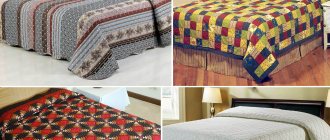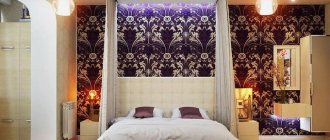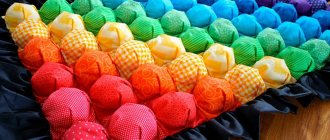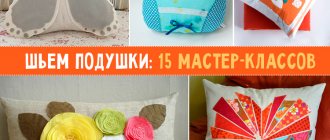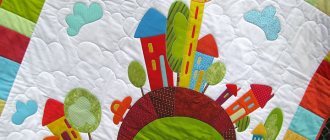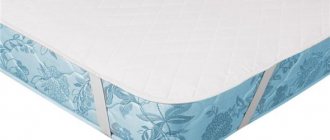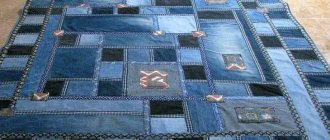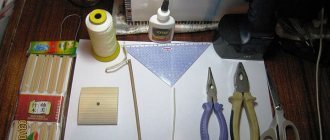Bed sets attract the attention of craftswomen. Favorite things include blankets and bedspreads. They are large enough to give freedom to imagination. There are many techniques for creating and transforming these things, but now we will consider the most interesting option - a bonbon blanket. What it is, how to sew it, what materials are needed - all this can be learned from the article.
What kind of blanket is this
Bonbon is a fabric product, the front and back sides of which are very different. On the one hand, this is an ordinary thing, and on the other, a set of small poufs sewn in the correct geometry. The edges of such crafts can have a wide edging. There are other ways of framing - trimming with ruffles, tassels, pom-poms.
The products are made from good textiles with careful selection of colors. They are essentially blankets made from pillows. The manufacturing technique is a type of art; it differs from patchwork in its texture.
A DIY bonbon blanket can be used as a rug for a child. The item can be used as a blanket on a sofa or a crib. Another way to use a marshmallow blanket is as a blanket.
Colors
Plain, two colors, three colors
When making bonbons, it is extremely important to consider the color scheme. It looks great as a single-color option, or a combination of several, two or three, solid colors. The selected combination can be very contrasting, for example, a combination of blue and red, red and green - or with a soft color transition, when a lighter shade is used in a pair.
In addition, the construction of colors itself is varied: with the help of squares you can create a checkerboard pattern, you can achieve a gradual flow of colors from one edge of the blanket to the other - the scope for imagination is limitless!
Color spectrum
As already mentioned, the choice of colors is limited only by your tastes. It could be pink, turquoise, white, yellow, mint blanket, blue, etc. It is not necessary to use plain fabrics; you can also add an original print, for example, an image of stripes, triangles, circles, small schematic images of animals, clouds, etc.
Keep in mind that blankets with a geometric pattern in darker colors are more suitable for boys, for example, blue-blue, green, white-blue, white-blue, blue-black, optionally black and white, etc.
Girls will prefer bright or, on the contrary, soft-airy, pastel colors. A good option for a print would be flowers, animals, children's drawings, etc.
Necessary materials and tools
To make a bonbon blanket with your own hands you will need:
- textiles of several colors, selected in the same range;
- textiles for the base - this can be chintz fabric or an old sheet;
- padding polyester or holofiber;
- threads to match the color of the fabric;
- needle and pins;
- scissors;
- pencil;
- ruler;
- sewing machine.
Another mandatory element is templates; patterns based on them are made at the first stage. The dimensions of the square fragments must have sides of at least 8 cm. You should not make them larger than 40 cm - this will spoil the appearance of the finished craft. The base parameters should include 2 cm on each side for the seams.
You need to determine how much holofiber or padding polyester you need for bonbons yourself. This is done after it has been decided how many square fragments the thing will consist of and their sizes.
How much fabric you need for a bonbon blanket is determined based on the size. If it is a small rug, you will need one amount, but for a double bedspread it will be a completely different amount. There is no calculation algorithm, so it’s worth calculating using the pattern.
Design options
Bonbon is a technique that implies the presence of many options for color and texture combinations in one product. You can combine ottomans or pillows in contrasting shades, or, on the contrary, you can create calm combinations. Delicate floral designs and pastoral motifs are good for a bedroom, girl's room or living room with a classic interior. Chocolate and beige make a dynamic and at the same time traditional combination that creates warmth and comfort. Wine shades add chic to the atmosphere.
If you want to create something completely unusual, metallic textures, foil-like fabric, shiny satin and crepe-satin combined with matte details will come to the rescue.
Decorative and functional model option
If the blanket is not intended for use by small children, it can be decorated with a bright edging with rhinestones or sequins.
As for the arrangement of parts by color, it all depends on the choice of the master. He prepares a scheme of color combinations in advance, thinks through how and in what quantity to place squares in a horizontal row, and makes the overall appearance of the product attractive.
Mint or lemon in combination with gray, pink in combination with gold - the color scheme of bonbon blankets can attract attention, relax the eye, and create accents. Considering the volumetric design of the product, it is not only a convenient and functional item, but also takes up enough space in the space, so it is worth considering its appearance in advance.
The texture of the fabric can also serve as decoration
If we talk about the difference between children's and adult models, then lush-looking pillows are more appropriate for the play environment of a children's room. As for the choice of colors, all kinds of bright ottomans, juicy and eye-catching, are suitable for children. You can also opt for calmer pastel options. If the fabric has large prints with famous fairy tale and cartoon characters, you can use a pattern measuring 10 by 10 centimeters or more for the ottomans. Other large patterns that combine with each other are also suitable.
For adults, the decisive factor is the overall style of the room and color in combination with the color schemes of the product.
The size of the squares may vary
How to sew a baby blanket with your own hands
Want to make your own bonbon blankets? Then we move directly to the manufacturing process itself.
The thing turns out to be small, but no one bothers you to add several rows to increase the dimensions.
This is what the blanks for the product look like. Next, let's take a closer look at their manufacturing process.
A square piece of textile in the selected color scheme.
And a piece of cotton fabric of the same size, 1 cm smaller than the front part.
By aligning the two edges of both blanks, we will get a small fold in the middle part. We bend it carefully. This is necessary so that children's bonbons have a relief shape.
We sew the first side with a machine.
On the second side we also align the edges, creating a fold. Having carefully folded it, we sew it with a machine.
We do the same with the third party.
We should end up with a pocket like this.
Fill the squares to capacity with filling until a round shape is formed.
We sew up the fourth side and the first piece is ready.
One by one we continue to stitch and stuff the square fragments, laying them out on the floor. You can immediately build a drawing based on the diagrams to see what kind of baby blanket you will get.
When all the square poufs are ready, it will look like in the photo.
You can start connecting the “puzzles”. Folding the wrong sides together, sew the joint.
The photo shows two pieces stitched together.
But two rows are already ready. To sew a bonbon bedspread, you don’t need to stop there.
Once all the squares are sewn together, we begin creating the edges. To do this, we lay pieces of calico fabric on the product, as shown in the figure, and sew them to the outermost row of fragments. You can choose the width of the stripes yourself.
To complete the work on the bonbon step by step, you need to hem the base with your own hands, or rather with a machine. It could be a regular sheet.
Place the base on the carpet and place the blanket on top. We align all the edges and secure them with pins.
To connect the base to the front side, you can use a long strip of fabric in one of the colors that was on the poufs.
First we attach the strip to the front side.
Then we sew the base to the strip and the bonbon blanket for a boy or girl is ready.
Recommendations
Independent creation of products using the bonbon technique allows you to bring to life the most diverse and unusual ideas. Such “marshmallow” crafts will decorate any interior and make it more individual.
Recommendations and advice from experts will help you fully implement your planned projects.
Adviсe:
- In order for the product to turn out as intended, you first need to draw up a plan and draw a diagram of the location of the “ottomans” in accordance with the drawing.
- The folds on the pads should be symmetrical and the same on each side. It is best to make them counter and try to lay them exactly in the middle.
- You should carefully consider the choice of fabric for the base. The material on the inside should not cause discomfort or allergies, especially if a baby blanket is being sewn. It is best to use any cotton fabric for this purpose, for example, take an ordinary sheet.
- The material for the front side must be selected in accordance with the intended purpose of the product. What works on a rug won't always look good on a blanket.
- It is not necessary to cut a whole piece of fabric to make squares. Stores often sell a variety of fabric scraps. They cost practically nothing, and as a result the product will turn out not only beautiful, but also on a budget.
- An additional layer of padding polyester between the front part and the base will make the blanket truly winter.
- It is not recommended to use cotton wool as a filler - after washing it will roll up and the product will become unusable.
- The optimal size of “ottomans” is 12-20 cm.
- The child will definitely like something made from bright, multi-colored pillows, assembled in a geometric pattern or, on the contrary, a plain, cream color, which will enhance the resemblance to marshmallows.
- The product can be decorated with piping, satin ribbon, frill or braid with small bombs.
You can create a patchwork masterpiece with your children. A child who has a hand in creation will certainly enjoy it even more.
Photo gallery
Below are options for making products using the bonbon technique.
Origin
The “bonbon” technique (also called “biscuit”) is one of the techniques of patchwork - sewing from scraps. Clothing and household items sewn from various scraps have existed among many peoples of the world since ancient times, since fabrics have always been in short supply and it was impractical to throw away scraps. Patchwork as a trend in decorative and applied arts developed most strongly in England and America, where bright and beautiful fabrics were received from the colonial states. Russia also had its own patchwork technique (just remember the blankets and bedspreads of our grandmothers and great-grandmothers!).
The bonbon technique, in comparison with other options for making patchwork products, is actually very simple. At the same time, the product looks incredibly impressive.
Many mothers on maternity leave with children are trying to start their own business. This is how we get workshops that accept orders for the production of designer textiles for children. Unique crib bumpers, letter pillows, sleeping cocoons, bed linen, discharge envelopes - all this is extremely popular today to make to order. It is in such workshops that “bonbon” blankets are made according to customers’ designs in unique color and style solutions.
Description
This original quilt is a variation of patchwork quilts. But the special technique of its manufacture turns this model into an airy and elegant interior decoration. After all, the highlight of this type is not just the colorful shreds, but the fact that it consists of components that look like small ottomans or bright bubbles.
It has different names: bombon, biscuit blanket, ottoman blanket, bonbon, and even marshmallow blanket. Therefore, by choosing the color and material in accordance with your personal preferences, you can sew with your own hands a wonderful, warm and beautiful blanket for your beloved child.
Ingredients for bombon coffee
Bombon coffee (bonbon) contains a lot of condensed milk, which masks the shades of coffee taste, so it makes no sense to use expensive single-varietal Arabica beans to prepare the drink. Bombon, made from 100% Arabica coffee with a chocolate flavor, has the best taste; experts recommend Guatemalan and Indian varieties. However, condensed milk neutralizes bitterness well, so those who like to experiment can prepare a base from a mixture of Arabica with Robusta or, in the Asian style, with Liberica.
For the coffee base, you need non-chlorinated, unboiled water with a mineralization of 75–250 mg/l.
To prepare bombon coffee (bonbon), condensed milk of any fat content is used. However, the drink is not a diet drink, and the difference between low-fat and condensed milk containing 8.5% fat is only about 50 kcal (per 100 g), so you won’t be able to save calories in any case.
Calculation of squares for sewing
You need to calculate using the bottom square.
Calculation of squares using the example of a finished product 30x30 cm.
If we take the size of a square 10×10 cm, in finished form, and the size of the product in finished form, 30×30 cm, then we divide each side by 10 and get the number of squares, i.e. 3 pcs. in width and 3 pcs. in length. Total 3×3=9 pieces, squares in total.
When cutting the bottom square, add 2 cm to the finished dimensions for allowances, and we get 12x12 cm.
The size of the upper square - to the size of the lower square (10 cm), add 2 cm for allowances and 4-6 cm for folds, i.e. the minimum size of the top square will be 16x16 cm, the larger the allowance for the folds, the higher and more magnificent the bombon will be.
Calculation of squares using the example of a finished product 160x80 cm.
How to calculate squares for a product size, for example 160×80 cm, with the finished size of the bottom square being 13×13 cm, we also divide the length and width by 13.
80÷13=6.1 Take the number 6, i.e. it will be 6 squares wide. 160÷13=12.3 Take the number 12, i.e. it will be 12 squares long. The total number of squares is 6×12=72 squares.
Also, when cutting, we add 2 cm to the dimensions of the bottom square for allowances, so the bottom square is 15x15 cm in total.
We also add 2 cm to the top square for allowances and 4-6 cm for folds.
Calculation of squares for sewing using the Third Technique
Calculation using the example of a finished product 41x41 cm. The size of the upper square is 21x21 cm, the size of the bottom square is 13x13 cm. According to these data, it turns out 3 squares in width and 3 squares in length. Total 9 squares.
We draw squares on the fabric, start from the corner, first draw an allowance of 1.5 cm on both sides, then draw vertical lines, square size, 13 cm, then draw a line 1 cm wide, from the first, then again the size of the square 13, after 1 cm, allowance and so on. Then we draw horizontal lines of the square, only 13 cm, without allowance, and then we make the same allowance of 1.5 cm on the two remaining sides, and cut it out.
Cutting width – The size of the bottom square without allowances, multiplied by the number of squares in width. Plus 3 cm for allowances and plus the number of stripes (3 pieces), since allowances are made of 1 cm. 13x3=39 (cm) 39+3+3 = 45 (cm)
Cut length – The size of the bottom square without allowances, multiplied by the number of squares along the length. Plus 3 cm for allowances. (13x3)+3=42 (cm.)
What is it for?
The purpose of the bonbon blanket is more decorative than functional. Of course, you can cover yourself with it, but it’s still a pity, because it can wrinkle and lose its attractive appearance. Therefore, the main purpose of such a product is a bedspread.
A set of “biscuit” textiles will look very nice – a bedspread and pillows or a bedspread and soft bumpers for a crib.
You can use a “bonbon” as a blanket if the child is still very young, up to about a year old. Babies, even if they are very active in their sleep, will not cause much damage to the blanket.
For girls, such a blanket can last for years, right up to college and beyond. Women of any age will most likely like a lush and delicate product. For boys, the bonbon blanket will most likely be suitable until primary school age. Then the bedspread will have to be replaced with a more solid one.
Adults can use it as a blanket during pleasant gatherings in front of the TV or with friends. It can serve as a bedspread for the bedroom or be part of the decor of the living room, decorated in light, “marshmallow” colors.
Reviews
Moms are delighted with these blankets. They look great in the interior, decorate children's (and non-children's) rooms and create coziness and a special mood.
One of the disadvantages noted by users of these blankets is their high cost. 5 thousand rubles per piece - not everyone is willing to pay that price. This encourages many mothers to sew “bonbons” themselves. However, not everyone has the perseverance and patience to complete the task.
The “marshmallow” blanket requires special care - delicate washing with a good spin. The filling inside the pads will have to be straightened out by hand after washing. You cannot iron the blanket from the front side (the synthetic filling will simply melt) - only steam it from the backside. Mothers also note that a bulky blanket takes up a lot of space when folded and is inconvenient to store in the closet.
